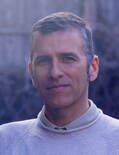Great Plains Evenings
Review of Prairie Architecture by Monica Barron
|
Prairie Architecture, Monica Barron’s new, elegantly plainspoken collection of poems, details the building of a particular kind of life in a particular place: an intelligent, sensitive, engaged existence in the American Midwest. “Yellow Morning,” the first in the collection, orients the reader to this world where these poems are largely set, a sometimes hot, dusty, windblown place where “heat tremolos in silence / that yellows the ditches, the dogs covered in dust.” On the horizon, the promise of a storm. Not rain, but another kind of nourishment: “A distant dust cloud announces the mail.”
For the speaker of many of the poems, it’s made clear that hers is a life of letters. Dotted throughout the collection are several postcard poems, written in response to their pictured places or the captions scrawled on their backsides. The language and images are grounded in the ordinary, everyday world of farm country. It’s a place of harsh natural beauty—desolate landscapes (various poems reference a “monotony of crops” and “Miles of corn stubble”), decaying vegetation, frozen rivers and lakes—and harsh realities: hunters, slaughtered deer, aging, death. Life is weathered down to the soft, chipped, patina of old rocking chairs on peeling porches, old dogs underfoot, old ladies hanging out laundry and tending to their bird feeders. People gather to drink outside under dark trees on hot nights, and to gossip in the beauty parlor. “‘The small towns around here / are all dead,’” a character remarks in “Modern Beauty Center,” yet the speaker is aware of life teeming all around her, from the “ratty dog” to the “dull braying / constellation” of geese flying overhead, noting “there’s a web of lives / out there maintained by something other than money / changing hands.” “Meditation from West of the River” reflects on a long relationship that is in some uncertain state of being. The poem opens in a room with “The house lights up” and the “wreckage of dinner” still on the table, suggesting the performance is over and it has not been a success. The meal has been shared by two people on intimate terms: “I understood what it meant when you rose from your chair, / crossed the room, ran your hands through my hair.” The speaker follows this person into a dark kitchen. “As I closed my eyes to kiss you I was aware / of the gray the light was catching in your hair.” This shock at the passage of time takes the speaker back to an earlier memory of being a girl on a beach. “In pictures of that time / life looks uncluttered,” she’s startled to realize. “Say what you want about memory, it can be so clean.” Lost in this kiss, and deeper in this memory, the speaker tries to locate herself: I was thinking a heart could hold heat like sand after a sunset. I was on the verge of trying to tell you this when the sky began to darken, the sand turn cold. The kiss broken, there is a sense that her lover’s feelings have again cooled. The speaker goes on to provide backstory about the relationship, recounting a kind of obsessive lovesickness where “I learned nothing about / being alone.” She traveled constantly to be with her lover. She recalls: I must have been very young to think two days of love could sustain me. I must have been very young to think it was love at all. In other words, the long-distance thing didn’t work out. Yet the two are reunited here, where the speaker wants to believe she’s been given another chance. She doesn’t doubt the intensity of her feelings, and believes her lover is in denial about the same: “Between two graying temples / it can always be silent. As long as you’re not listening.” The speaker retreats to mope, to “lie on a sunny slope,” but rather than feel overcome by sorrow, she instead gets interested in the natural world around her, noticing “the blue of the darkening sky / against the shoe factory’s worn brick. / Love might seem possible in that light.” The speaker, again considering the relationship, notes: “I know / that feeling, but it won’t come back.” Yet it’s possible it’s never left her. It seizes her in its grip still. A relationship at two points in its life is considered in the poems “Something is Certainly Ending” and “Polar Vortex.” In the former, a couple drives to a remote cabin on New Year’s Eve to visit one of their mothers, an older woman, who seems to be diminishing in strength and spirit. “She can’t shovel snow off the roof anymore. Her hip aches. / She can’t get out of chairs, maintain her balance. She waits winter out.” The woman is part of a world that’s disappearing all around her: the loons who no longer come in summer, the elk who no longer drink from the lake that bears their name. |
The couple sleeps under an old quilt the woman made (“It took her 25 years to finish”). It shows up again later in “Polar Vortex,” only this time
I am a guest. You sleep under “The Drunkard’s Way,” the heaviest quilt your mother ever made. Checking the pipes in the basement of the frozen house, the speaker wonders “why your pipes hadn’t / frozen. They must run deep, deeper than mine (which used to be / ours).” Life is weathered down to the soft, chipped, patina of old rocking chairs on peeling porches, old dogs underfoot, old ladies hanging out laundry and tending to their bird feeders. The speaker recalls an earlier point in their relationship when they were together. It’s a memory of spring.
There were curtains over the back stairs door we opened when there were barely lilacs. All the touches then were full of hope. The passage of time is a prominent theme in this collection. “Bloodletting” considers the work of dealing with aging parents. “We have to talk about Mom, my sister said. / Do we ever stop?” the speaker wonders. “Absence is not the dark thing I imagined,” she realizes later in “An Anniversary of My Father’s Death,” but part of the cycle of the rhythms of the world. It’s cayenne lilies sprouting from grassy ditches, turtles sunning themselves, old women pumping gas and selling melons. Strong light over the fields. The poems in Prairie Architecture often detail difficult experiences and painful emotions, but the overriding feeling is one of joy for simple pleasures, and the simplest pleasure with the greatest yield is paying attention. Strong feeling, the poems in this collection suggest, lifts us out of our ordinary lives, yet it’s the ordinary, when noticed, which becomes extraordinary, and sustains us. In “This moment I’m living in,” the speaker considers the work of a poet she admires, aware of her own shortcomings: Me, I’m porch-sitting in a rocker whose cane seat is breaking, leaving me to sit like the old woman in Candide who lost a buttock blockaded in a castle. The view from that perch is not a gorgeous one. A movie theater blocks the sunset, the landlord across the street “tore up / the concrete from the sidewalk to the porch, / intending, I guess, to build a ramp.” The speaker’s musings are interrupted when she notices an old woman attempt to climb up that slope, surrounded by “Two men who don’t know what / to do.” The old woman makes it to the house, and different neighbors settle on their porches. The speaker interrupts her reporting to say, “I wish this poem were more lovely.” Yet there is a loveliness to the account because it’s so attuned to the moment and all that it contains. The political has seeped into everything these days, and these poems are no exception. “We Were Lied To,” about the lead-contaminated water in Flint, Michigan, has special resonance for the author when her biography is taken into account: “Born in Michigan, she has never quite gotten the Great Lakes out of her system.” In “Looking for Democrats in Novinger, MO,” the speaker canvasses for Hillary Clinton shortly before the 2016 U.S. election: sent us to a town whose name they couldn’t pronounce—which meant they couldn’t visualize what they were asking us to do. But the poem turns into a eulogy for the poet Leonard Cohen, whose “death bumped Donald / and Hillary off page one.” The speaker, traveling to Canada, the country Cohen hailed from, finds solace looking up at the sky: For the moon rising over Montreal whose wet cobblestones shine like faces turned toward the light, gratitude. The same moon shines on a Manhattan tower. No matter what the subject of Barron’s poems first appears to be, nature is the link, nature is the balm. In Prairie Architecture, she’s assembled something like an album of pictures of the place she lives (which is both in and outside of herself), to show us the life she’s made and what she’s made of it. It’s both of the moment and timeless—the hallmarks of a classic. |

REVIEWED BY MICHAEL QUINN
Michael Quinn reviews books for trade publications (Publishers Weekly, IndieReader), literary journals (The Adroit Journal, Green Mountains Review), and newspapers (The Red Hook Star-Revue), as well as for his own website, mastermichaelquinn.com, under the heading “Book Report.” His reading list for the reviews he’s not assigned is determined by interest, whim, and chance—and by what’s available at the Brooklyn Public Library.
Michael Quinn reviews books for trade publications (Publishers Weekly, IndieReader), literary journals (The Adroit Journal, Green Mountains Review), and newspapers (The Red Hook Star-Revue), as well as for his own website, mastermichaelquinn.com, under the heading “Book Report.” His reading list for the reviews he’s not assigned is determined by interest, whim, and chance—and by what’s available at the Brooklyn Public Library.
